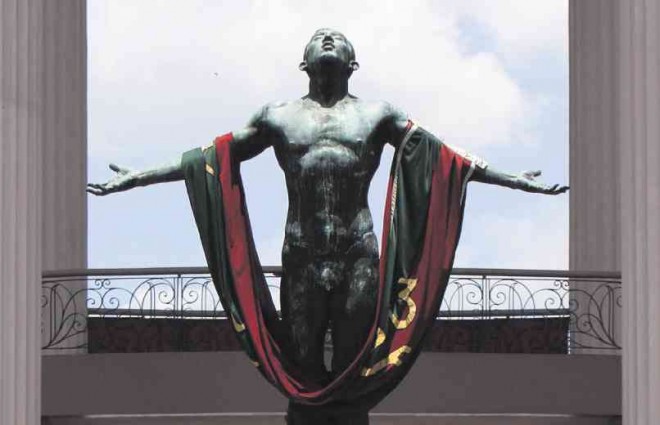
THE UNIVERSITY of the Philippines’ Oblation in Diliman, Quezon City, is garbed in “sablay.” LYN RILLON
BAGUIO CITY, Philippines—The University of the Philippines’ (UP) “sablay” has replaced the traditional toga as the academic costume in the country’s premier university.
So while thousands of UP graduates last weekend had this loose sash moved from their right shoulder to their left as a sign of having graduated, more than 60 weavers here, some not having reached high school, are also beaming with pride like proud parents.
Easter Weaving Room (EWR), owned and managed by Philippine Episcopal Church and established in 1908, has been creating the UP sablay for the past seven years.
Virginia Doligas, EWR general manager, said EWR gets only more than 3,000 orders of sablay every year. The rest are made by a weaving center in the Visayas, she said.
“We start the production of the UP sablay in November,” Doligas said.
She said a weaver could finish a whole warp or swath of cloth in 15 days. A warp can be made into 150 sablay.
Other groups do the sewing and embroidering of the sablay, Doligas said.
The dimensions of the UP sablay are copyrighted, she said.
Information posted on the UP website said the sablay carried the official colors of the university—maroon and green. Yellow gold, which stands for the high standards of values and excellence, was also used, the website said.
The sablay features the university’s initials in the ancient writing system “alibata.” “The indigenous letters, originating from the indigenous alphabet called ‘baybayin’ or ‘katitikan,’ are equivalent to the Roman letters ‘U’ and ‘P,’ respectively,” the website said.
“The curvilinear design called ‘ukkil’ or ‘ukit,’ which resembles a sprouting plant, signifies life. The geometric designs [in zigzag and diamond patterns] are common design elements gracing the attires and functional objects of indigenous peoples from Batanes [province] to Tawi-Tawi [province],” the website said.
“Arranged continuously and rhythmically, these geometric designs highlight the diverse cultural communities in the Philippines and the university’s pursuit of knowledge, cultural enrichment and scientific advancement,” it said.
Graduating students pay between P700 and P800 to own a sablay. Many prefer to borrow or rent one.
“Some of the alumni who could not afford a sablay when they graduated [years earlier] would come to ask to buy one,” Doligas said.
She, however, would not tell if they sell sablay to walk-in customers.
Doligas said EWR sells bed covers, rugs, lamp shades, wall decor, ladies shoes, desk pads, pen holders, eyeglass cases, telephone pads, book markers, vests, coats, jackets, hats, slippers, sandals, belts, neckties, skirts, blouses, mufflers, stockings, hats, coaster napkins and many more, using traditional looms and weave patterns.
EWR was established to give Cordillera girls a chance to have a home economics class and earn on the side. Its original products were G-strings for boys and native skirts for girls.
The weavers were also taught to weave table runners and place mats for Americans living in the city. Frank Cimatu, Inquirer Northern Luzon